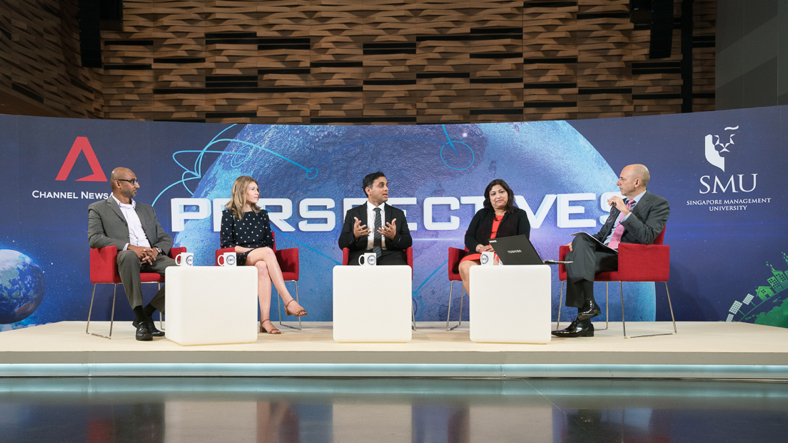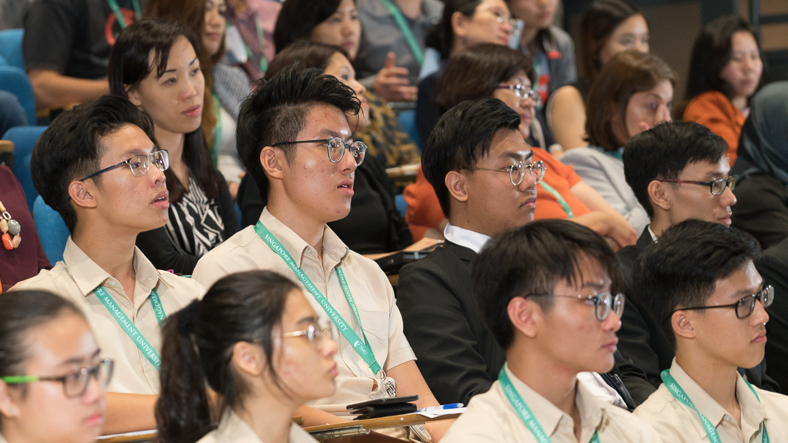
From robots that deliver amenities to guests in hotel rooms, to recommendations for the best sushi by Siri — the smart assistant that dispenses helpful reminders and tips from iOS — it’s a fact that artificial intelligence (A.I.) has pervaded our everyday lives.
While today’s digital generation may already be familiar with the benefits of A.I., the rapid rise of machine learning raises important questions about the impact of such technology on our future.
In these exciting yet uncertain times, SMU has partnered with ChannelNewsAsia on a panel discussion on the topic, Responsible A.I.: How to Save Humanity from the Dark Side of A.I., for the topical talk show programme, Perspectives. The panel consisted of SMU Associate Professor of Information Systems, Pradeep Reddy Varakantham; Board Member of Live with A.I., Emmanuelle Coulon; Group Vice President and Chief Architect of Oracle Asia Pacific, Christopher G Cheliah; and General Manager of Global Business Services at IBM Asia Pacific, Lula Mohanty.

A.I. in a nutshell
“A.I. is more of an augmented intelligence rather than artificial intelligence. It has given us amazing opportunities and has also enabled us to identify what defines us as humans,” said Ms Coulon.
Mr Cheliah described A.I. as a smart decision-making and data-processing technology that’s “modelled based on human neurons. It is designed to perform pattern recognition, process data and derive algorithms that would otherwise take humans several hours or days to do”. With this, it is hard for any individual or organisation to efficiently function without the use of A.I.
“With the use of A.I., nurses, for example, are dealing with data at a much faster speed with the benefits of automation, which means they can now devote more time and attention on patients instead of administrative work. A.I. has therefore reduced paperwork in general and created connections in different jobs,” noted Ms Coulon.
As A.I. plays an increasingly important role in spurring on innovation and efficiency, it is unlikely that a slowdown in the usage of the technology will happen anytime soon. While a majority of the audience agreed that government regulation should come into play with the usage of A.I., some remained unsure of whether such intervention would play a significant enough role in monitoring the use of A.I. in the modern world.

The fear of A.I.: Paranoia, or a real threat?
If a prominent business leader like Elon Musk is calling A.I. humanity’s “biggest existential threat”, it is understandable that the development of machine intelligence is being met with a certain degree of apprehension by the general public
Indeed, the notion of A.I. possessing a “dark side” probably came about as part of the age-old conflict of nature versus nurture. Because while A.I. was born from good intentions, it’s the malicious and unethical use of A.I. that created the “dark side” of A.I. that is known today. A.I. is ultimately an autonomous technology, and it was created with the purpose of easing everyday tasks for the average person.
“A.I. on its own is not malevolent. It does not carry harmful functions and intentions. However, once A.I., such as self-functioning machines and devices, is weaponised for malevolent purposes, that is when A.I. turns ‘dark’”, Ms Mohanty pointed out.
Another question on everyone’s mind is how much A.I. is naturally capable of doing and how much humans can teach it. While it is difficult to predict exactly how much humans can “teach” A.I., the idea of A.I. developing human-like consciousness is a widespread fear for the public.
This fear is being fuelled further by media riding on the A.I. trend with the time-worn tropes of technology being the key instigator of a dystopian future and machines taking over the world.
“With the media’s role in in portraying and amplifying on the dark sides of A.I. for entertainment purposes, it has inevitably caused fear in public’s eye as we become more afraid of whether A.I. will take over humans and ultimately eradicate what defines us as humans”, said Ms Mohanty.
Where does A.I. go from here?
With A.I. opening up infinite paths of opportunity and inevitable risks, humans and machines are becoming increasingly intertwined. So the real challenge is not so much about controlling the proliferation of A.I., but about training humans to responsibly harness this technology to create a positive impact.
“It is vital to be transparent about the systems that are being developed and what they can and cannot do. The responsibility of any harm caused by A.I. still goes to whoever develops the algorithm and coded the system so the important part is to make sure that the potential setbacks or mishaps be highlighted clearly to the public,” Professor Pradeep emphasised.
While the jury is still out on whether current technological capabilities will allow us to code morality and ethics into the systems, panelists agree that it is important to drive public awareness and educate a future generation, cognizant of the implications of A.I..
“It is important to educate the public and start implementing training courses into school and work systems on how to effectively use A.I. to ease jobs and enhance efficiency”, said Professor Pradeep.


